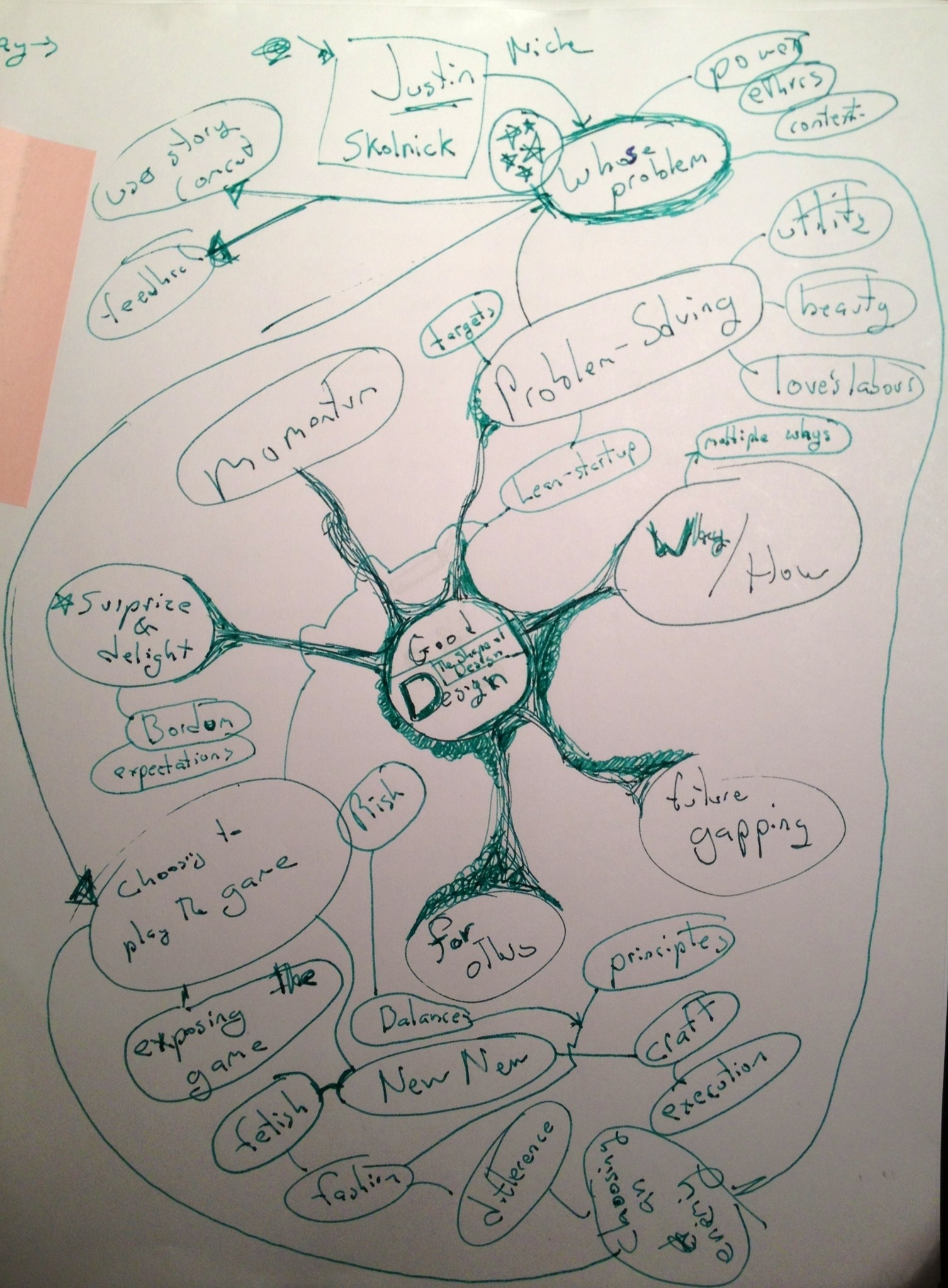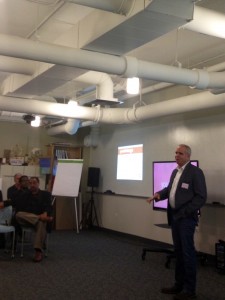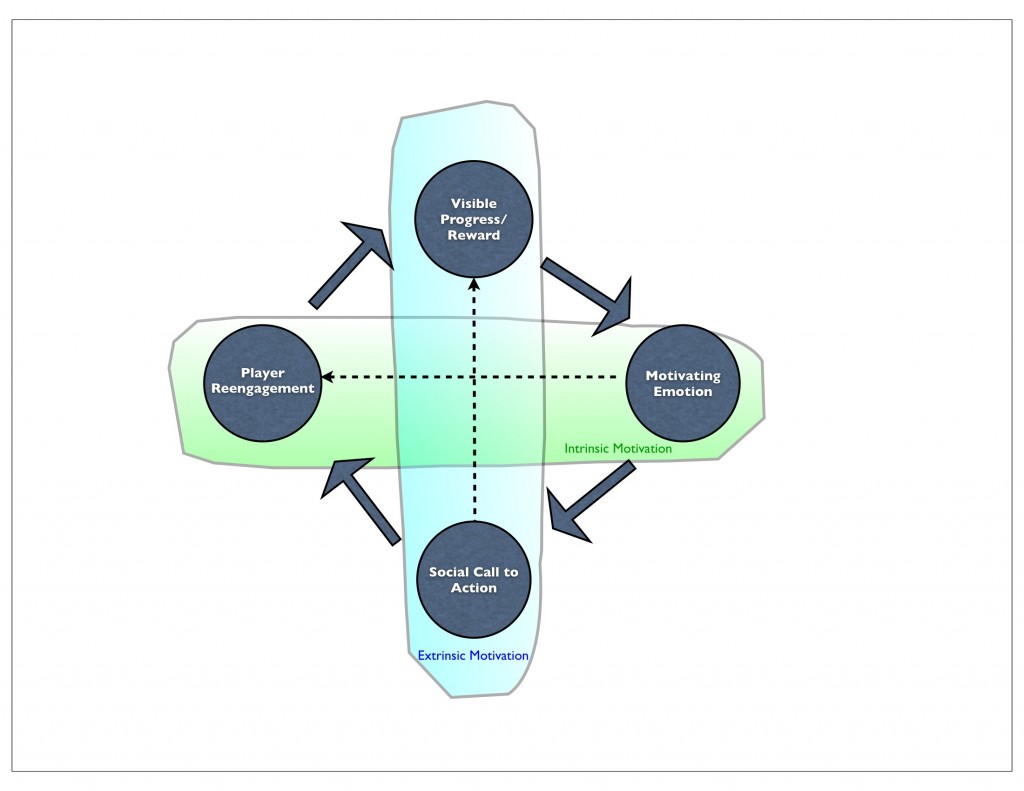Design Patents
November 26th, 2012Christopher Carani, Esq lectured on the importance of design intellectual property earlier this month at the Industrial Designers Society of America Chicago chapter at Beyond Design here in Chicago. His discussion was centered around an in-depth review of “Apple v Samsung” and how design patents took center stage in this case. Carani was very optimistic of the growing recognized value and power of design as evidenced by the legal trends he sees. Throughout the discussion Carani shared insights on how designers and businesses can best protect their UX design.
Highlights:
There is now a 700% increase in GUI filings in the US patent office in the last year.
Because of these types of cases and the rise of design patents businesses are being moved to avoid directing designers to “just copy” their leading competitor’s design. Comments were that Samsung has some very talented designers, perhaps now they will be able to design.
4 ways for designers to increase value
1 – Use broken lines and dotted lines (Broken lines may be used to show environment and boundaries that form no part of the claimed design)
2 – Use indeterminate break lines (The use of a separation and bracket to indicate that precise lengths are not claimed)
3 – Use multiple embodiments (form or scope) (As long as appearance and shape are similar)
4 – Show multiple applications (If there are minimal configuration differences)
Another point was the use of “flip book” type renderings to deal with the animations that GUI designs are more than ever innovating on.
There was a lot of discussion about prior art and the importance of that for enforcement and patent references. I think there are opportunities to combine this with a comparative analysis phase of projects in which designers make an inventory of preexisitng designs.
SEE ALSO
United States Patent And Trademark Office: A Guide to Filing A Design Patent Application
The Design of Design Patents, Part 4: Practical Advice for Designers
The Shape of Design by Frank Chimero: visual notes
October 24th, 2012Above is a photo of where we had our Chicago ux book club discussion. Wow it was awesome.
Below are my visual notes from the lively discussion.
My Top 12 ideas or quotes from the book
pxv
First, design is imagining a future and working toward it with intelligence and cleverness. Second, design is a practice built upon making things for other people.
p24
We can get closer to the wisdom of other people by having them explain their decisions – not just in How they were executed, but Why they were made.
p33
My work was flat, because it was missing the spark that comes from creating something you believe in for someone you care about. This is the source of the highest craft, because an affection for the audience produces the care necessary to make the work well.
p39
I find the best way to gain momentum is to think of the worst possible way to tackle the project . . . every idea you have after these will be better.
p54
Magicians don’t just create new things, they invent new ways of doing so.
p56
… our Henry Fords, our Billie Holidays, our Guttenbergs, Disneys, and Marie Curies – do not stand on the inside of what is possible and push; they imagine what is just outside of what we deem possible and pull us towards their vision of what is better.
p62
The best way to describe design is that it seeks to connect things by acting as a bridge between them . . . the design of a restaurant is meant to fuse with the chef’s culinary approach to create a more provocative and full dinning experience for the eater.
p64
Design can speak the tongue of art with the force of commerce.
p73
The primary purpose of the design is to have it do something particular, not be any particular thing … design is a field of outcomes and consequences more than one of artifacts.
p77
the best design has to offer much more than making problems go away … additive forces … it help us live well by producing and elevating new kinds of value, such as engagement, participation, and happiness … at its root, is simple people making useful things for other people.
p91
There are two successful outcomes when a design focuses on its audience: resonance [stories] and engagement [frameworks].
p91
“What if the audience is smarter than I am?” … it seems silly to not have a way to gather their thoughts, opinions, and proposed solutions.
Youth Design visiting Chicago
August 9th, 2012
I attended a talk at IDEA shop IIT about Youth Design (thanks Rachael Kaberon). Youth Design is a summer mentorship program that introduces inner-city high school students to careers in the design profession. Many of the Youth Design people from Boston flew in to speak and share their stories. It was founded by Denise Korn. She and Youth Design are doing some exciting work. Hopefully there is a bright future for them here in Chicago.
Much of the evening’s discussion was about diversity and workplaces and schools and careers and jobs. How can we fix the big problems. What can designers do? What can design companies and departments do? What should designers be doing to improve things over the long term? Is Youth Design workable in Chicago? The event had a high energy and much promise. I don’t know where things will go, but I am sure it will be interesting. They have done wonderful things in Boston and shared some incredible stories.
One of the speakers that evening (I think it Robert Lewis Jr) talked about designers and big problems. He asked why don’t we find designers working on these big problems and about how he thinks about designers and what they are like. He said designers are fixers. They fix things. They see something, see how it is, and see how it could be and make it so. They fix things. The other aspect he brought up was about designers and magic. He said that designers have magic and create things. A nice outside look at designers and design. Simple and clear. It’s how people see designers.
Youth Design seems to have crafted some good “fixing” magic.
Happy Gamification: Grand Unified Model of Motivation
August 2nd, 2012Here is my visual explanation showing why I don’t see a useful distinction between intrinsic and extrinsic motivation if you have a well designed gamified experience. These two separate systems of extrinsic and intrinsic motivations come together nicely if you overlay a social engagement loop on top of them.
It is a grand unified model of Motivation and the most powerful of those motivations is the emotion of happiness.
My notes for Passion Capital The World’s Most Valuable Asset by Paul Alofs
July 31st, 2012Here are my notes from Passion Capital by Paul Alofs.
A nice inspiration read. Andrew Daniel had sent out an article based on the book and it was interesting enough that I bought the book. Passion Capital is an easy read and full of stories (both personal and from history) that Alofs uses as examples of his seven principles which he says are the basis for passion capital. They are: Creed, Culture, Courage, Brand, Resources, Strategy, and Persistence. His formula for passion capital is Passion Capital = Energy + Intensity + Sustainability.
Book notes by page number
p6
Passion with a plan.
p19
“Whole Foods has a deeper purpose.” Mackey has said. “Most of the companies I admire in the world have a deeper purpose.”
And what is that purpose? “Business serves society,” he said in a profile in the New Yorker. “It produces goods and services that makes people’s lives better. Doctors heal the sick. Teachers educate people. Architects design buildings. Whole Foods puts food on people’s tables and we improve people’s health. We provide jobs. We provide capital through profits that spur improvements in the world. And we’re good citizens in the communities; we take our citizenship very seriously at Whole Foods.” (Five per cent of profits are donated to charity.)
p50
He talked about the future. He looked like the future.
p60
The key is to understand your failures. “I basically have survived by recognizing my mistakes,” Soros has said.
p77
Some of them have been very successful. But the larger companies are losing market share to smaller, more innovative companies that are making more interesting beer.
p96
At any given moment, certain resources have inherently more worth than others. The formula is rarely static. You need people or ideas or money or time. But what you need most changes month to month.
p128
At the time (late 19th century with Fredrick Winslow Taylor), the world was in the throes of the machine age, and the goals was to have people, as far as possible, mimic machines.
p144
Strategy in business depends on three issues: know yourself, know the enemy, know the market.
p148
Most strategies overestimate what can be accomplished in a year and underestimate what can be accomplished in five years.
163
The public sector is short on innovation but has responsibilities to society. The private sector possesses innovative ideas, but few of them are directed toward the larger benefit of society.
177
But a larger problem was that Ballard cared less about victory, which he couldn’t dictate, than exercising power, which he could. Ultimately, his passion wasn’t for winning but for power.
185
Where is the zeitgeist going? You need to hire for what is coming next, not what happened last.
196
What did I create? What do I value?
196
… playwright Arthur Miller said, all we can do is hope to end up with the right regrets.
“From Stuff to Story”
July 31st, 2012Great dinner at Jaipur (847 West Randolph) and conversation tonight with the Chicago Overlap crew for the occasion of Shel Kimen visiting Chicago. Shel Kimen made an interesting turn of phrase early in the night. She talked about “from stuff to story” when she was talking about her work in Detroit.
That phrase “from stuff to story” captured my imagination. I couldn’t stop thinking about it all dinner long.I kept repeating it over and over. When I got home I Googled it. Guess what – not a single reference. “No results found for “from stuff to story”.” My ears tingle when I find something I can’t find a Google result for a phrase.
Why haven’t people written that phrase? Why haven’t they thunk that thought?
People think the story comes first and then stuff comes from that. That first someone has to talk about something before it can come into the world.
I heard Shel’s phrase as a affirmation of “stuff first.” Naming and stories and labels comes afterwards.
It brought to mind the difference between labels and labeling, between names and naming. (From “Sorting Things Out: Classification and Its Consequences by Geoffrey Bowker and Susan Leigh Star)
Going “From Stuff to Story” makes it harder for stories to make and keep categories invisible and gives us a fresh way to examine and see our built information environment. Stories are the scaffolding of information infrastructures that surround our stuff. So I think I will give it a try to work “from stuff to story” for awhile and see what happens. 😉
References
My notes for Grouped: How small groups of friends are the key to influence on the social web by Paul Adams
July 26th, 2012Here are my notes from Grouped by Paul Adams
A quick read. A good introduction and overview to social science thinking and theory. For those of you with backgrounds in the social sciences this book will be good for you to read for ways to simply and clearly speak about the concepts with colleagues or clients without using jargon. For those of you from other backgrounds this is a good introductory book.
The most valuable concept is on page 89 where Adams writes about “Showing others’ behavior” as a way to influence people. This “showing the activity of other people” is known as social proof. On the social web that we are building there are escalating opportunities to collect and show activity streams. He gives many examples about how the web is “moving away from its current structure of documents and pages linked together, and toward a new structure that is built around people.”
For a business anthropologist, it is heartening to hear Adams call for rebuilding their businesses around people and social behavior.
Book notes by page number
p13
What we’ve been already learned from the ability to observe and quantify human relationships has moved us away from the myth of the “influential” and toward understanding how groups of friends talk about businesses, brands, and products.
p44
When we speak of five intermediaries, we are talking about an enormous psychological distance between the starting and target points. We should think of the five points as being not five persons apart, but five circles of acquaintances apart — five structures apart. This helps to see it in its proper perspective. — Stanley Milgram.
p72
It’s easier to attribute success to an inspirational person, rather than try to understand the complex network in which they are situated.
p89
Showing others’ behavior is a powerful way to influence people. Behavioral change precedes attitudinal change. Facebook’s Open Graph shows the activity of other people, and gives people tools to undertake the same activity.
p111
We need instead to market toward emotion.
p124
3 ways of encouraging people to change their behavior: 1) Change people’s environment: this is the most powerful way to effect change. Environment stimulates specific behaviors so it’s much easier to try something new in a new environment. 2) Increase the benefit relative to the cost of a new behavior. 3) Ensure that people observe others doing the desired behavior and then see others being rewarded for it. We learn new behaviors by observing the people around us.
p127
It’s much easier to invoke behavioral change first, and attitudinal change later. You can motivate behavioral change by changing people’s environments, breaking down requests into much smaller requests, and ensuring people see others doing the desired behavior.
p134
Permission marketing happens when people give marketers permission to send them messages.
p149
Starting with small requests for behavioral change often eventually leads to attitudinal change.
Gamification with fruitbuddi
July 25th, 2012Last week I had the pleasure of skyping with Taylor Reynolds and Brandon Rivera-Melo of fruitbuddi about gamification. fruitbuddi is a product to “enable children to make healthy decisions in the grocery store.”
To direct the conversation we used the conceptual framework for gamification. It helped structure a critique of the fruitbuddi and exposed some gamification experience opportunities. The most interesting ones came out of considering the different levels of players and the social learning aspects of how different aged children and families might use the fruitbuddi and learn how to use it better as individual players moved from novice, to problem solvers, to masters.
We talked also about the behavioral onramps that exist in the kitchen or dinning areas that might reference and prime the anticipated use or recollections of using the fruitbuddi in the store. Taylor and Brandon asked about internal/external motivation. That isn’t in the framework. I purposely left it out. In the framework there are “positive emotion” loops that come from players trying to move to the next player level through the challenges. The loops are explicit, but the resulting positive emotion concepts are not. That is a weakness of the current framework that I need to fix and clarify. The discussion about how to embed more positive emotions into any (even minor) action/activity the players take did yield some more possible enhancements.
Overall the conceptual framework was useful for looking at a experience and having a structured dialog about how it could be gamified.
References
Thank you to Sami Nerenberg, Director of Operations at Design for American for putting fruitbuddi in touch with me.
The 1:9:90 rule of Social Media Theory. Does it apply to gamification?
July 25th, 2012Social Media meets Gamification
Last night at dinner with Michael Leis I shared the latest Conceptual Framework for Gamification before posting it online. Michael has extensive experience in social media. One of the things he said that really struck me was “I think the novices are much more numerous.” I asked why, and he brought up the similarities between this framework and the 1:9:90 rule.
The 1:9:90 rule would apply in such that
Masters : Originators 1%
Problem Solvers : Editors (Commentators) 9%
Novices : Lurkers 90%
The gamification allure for companies tends to center on the masters just like with social media the companies are focused on the User Generated Content that comes from the Originators, yet the pay dirt of social media comes from the lurkers, the readers, the masses. Likewise the paydirt we should look for in gamification is with the novices.
References
Conceptual Framework for Gamification







